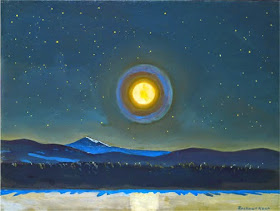 |
| Rockwell Kent, Moonlight in the Adirondacks. |
1. The late Canadian landscapist
Robert Genn suggested that, “rather than go with your first choice in a composition, go with your second choice.” Why? I think because we’re scared little puppies and we want to be told we’re good artists, so we stand there summoning up every bit of
what we know works before we even begin
. But the first composition that “comes to you” is probably one you’ve
received from paintings you’ve studied and liked. "It’s likely to be in your comfort zone, but it is your second choice that will stretch your capabilities and expose new creativity. How to do this?" Genn suggests the following: “slowly rotate yourself in a full circle, taking every possibility into consideration. Sort out and at least anticipate the potentials of every angle before you start.”
Sometimes it'll just click. Something jumps out at you and suddenly you can imagine the the general outline of the finished piece, even though you have no idea how to even start - and
that's your painting.
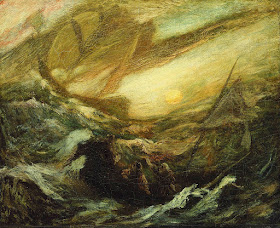 |
| The Flying Dutchman, by Albert P. Ryder |
2. Feel, don’t think, your brushstrokes. Try to occupy your mind by imaginatively entering into your subject. Feel your subject in your imagination and let your hand follow. Painting is about expressing a feeling. Allow your feelings, not just your eye or your head, to move your hand. Paint from your arm, not your wrist. There will be time for fussing - er, I mean "polish" - later.
3. Mix colors promiscuously, apply them relationally. Pare down your palette to the primaries and a few earths, forget "color theory" and just play. Be an alchemist - mix nameless colors (as
Eric Aho is fond of saying). Make a color and put it on the canvas. Make another one and place it next to the first one. NO FEAR. It isn't possible to mix "mud." Don't believe me? Look at the foreground color in the square that's front and center in the painting by Stuart Shils above. Well, yeah, that's "mud color," but it only makes the painting better when you notice it: look how well it relates to the surrounding colors, especially the warm pale yellow immediately above and the deep, electric violet to the bottom right. Paint that is
the color of mud is beautiful and absolutely right when placed on a canvas relationally and with intention. "Mud" (the bad kind) is something that happens
not on the palette but on the canvas when you smear colors together, usually because you're using numerous brushstrokes in a desperate effort to "fix" something (I think in most such cases the cause of the trouble isn't with the color you've put on but with its value. We end up trying to blend it into submission (resulting in muddy colors) - much better is to take off the stroke, remix the color to the proper value, and put it back fresh). Ideally: "Put it on and leave it on."
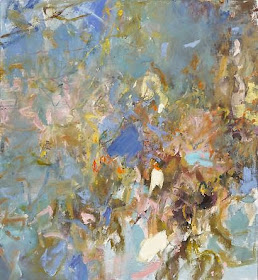 |
| Eric Aho, March |
4. Design, design, design. Pay more attention to what’s happening on the canvas than to what’s “out there.” Consider everything - color, shape, value, stroke - in relation NOT to exactly what's "there" in the world but to everything else on the canvas. Reject received compositions. Be a brilliant composer. Improvise: Play jazz. Ultimately, it’s not accuracy or faithfulness to the visible (to a particular marsh, mountain foliage color, or ocean wave), but what ends up on the canvas that makes the painting live or die.
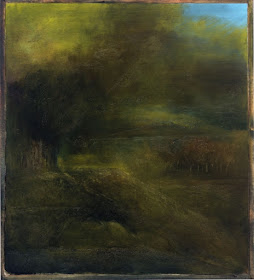 |
| Jake Berthot |
5. Maintain a dialogue with the painting. To open up this dialogue you have stop frequently, after every few strokes. Consider what’s just happened and instead of worrying about how to fix it, ask what it suggests about what might happen next. React imaginatively - yes, to your subject - but also to each new relationship of color and brushwork that you create. Everything you do changes the equation; the sooner you notice how it’s adding up, the better you’ll feel at the end. Oil paintings are infinitely changeable, and creativity ultimately mysterious - but if you can stop insisting that it it's your way or the highway, your painting may just start leading you where you
really want to go (whether you know it or not).
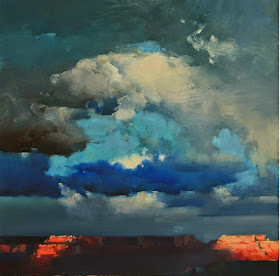%2BZhaoming%2BWu.jpg) |
Samsara (oil, 12x12") Zhaoming Wu, 2015
available at Abend Gallery |
6. Sit at the feet of masters. Not literally; I mean find the paintings that humble and excite you, that make your head explode, that make you say "Yes - THAT'S painting." They don't have to be by dead people (though some of them probably should be). Just let yourself be blown away by what an artist you've encountered has achieved. This isn't the time to ask "how?" Just feel it. Take it in. Look long. "Listen" to the painting, in part and in whole. See what someone has done, take a deep breath, and remember how it makes you feel. Implicitly understand the "why" - the only answer to which you need to know is: "Because Damn - that's PAINTING."
 |
| JMW Turner, Rain, Steam, and Speed, the Great Western Railway, 1844 |



%2BZhaoming%2BWu.jpg)




Great post Chris! Just what I needed today . . .
ReplyDeleteGlad glad to hear it!
ReplyDeleteEvery point here is SO needed by me,and so well-written. "Reject Conceived Compositions." My new motto. (similar to advice I read once: "Do 5-7 very different thumbnails of possible compositions of a scene... and then REJECT THE 4 OBVIOUS ONES!"
ReplyDeleteOoooo sketch 5-4---that's good Tom!
DeleteInteresting and helpful. Thanks so much!
ReplyDeleteThis comment has been removed by the author.
ReplyDeletePretty! This was a truly superb post. Thank you for your offered information.
ReplyDeletewww.renownpainters.com.au
true religion jeans
ReplyDeletelinks of london
nba jerseys
ray ban sunglasses
mulberry outlet
chanel handbags
the north face
ray ban
ugg boots
nike air force 1
coach outlet store
ugg boots
canada goose jackets
hermes bags
coach outlet canada
ugg outlet
ugg outlet
chanel handbags
michael kors outlet
ugg sale
cheap nfl jerseys
rolex watches
oakley sunglasses
adidas outlet store
cheap ugg boots
tory burch outlet
wellensteyn jackets
the north face clearance
oakley sunglasses
swarovski jewelry
louis vuitton handbags
coach outlet
michael kors factory outlet
soccer jerseys
canada goose jackets
cheap michael kors handbags
tory burch shoes
ray ban sunglasses
prada handbags
herve leger outlet
20151023caihuali
I am glad to read this post; this is truly a good site. Once again thanks! great western painting
ReplyDeletecoach factory outlet
ReplyDeletecheap jordan shoes
celine bags
nike free run 2
kate spade handbags
louis vuitton purses
louis vuitton outlet
michael kors outlet
michael kors outlet online sale
louis vuitton purses
louis vuitton handbags
ghd hair straighteners
kate spade outlet
timberland outlet
adidas outlet store
oakley outlet
oakley sunglasses
adidas wings
coach outlet online
coach outlet store online clearances
longchamp handbags
nike roshe one
tory burch boots
tory burch outlet online
coach outlet canada
abercrombie and fitch
louis vuitton handbags
cheap jordan shoes
christian louboutin sale
kate spade outlet
chenyingying0711
yeezy sneakers
ReplyDeletemichael kors factory outlet
adidas ultra
adidas ultra boost
yeezy boost 350
chrome hearts
air jordan
polo lacoste
nike huarache
cheap jordans
coach outlet
ReplyDeleteralph lauren outlet
seahawks jersey
green bay packers jerseys
coach outlet online
hugo boss sale
michael kors outlet clearance
cardinals jersey
giants jersey
oakley vault
"He doesn't find yourself everywhere close toil unit, Aside from at your head of the usb ports. Completely eventually says Ross on his own got inquired each the legal plan for you such instructions shortly in the aftermath of Kobach planned phrasing to buy a citizenship main issue wearing a July 2017 e-mail. {facebook.com | Cheap Ray Ban Sunglasses | Ray Ban Sale 90 OFF | Cheap Real Yeezys}
ReplyDeleteAnd the scholars would discard her or his side up as in the accepted yet pressing it'll stick to these types of a binding agreement and take them to boot camp.. Lal unveiled how the entire prospect of your pet pointing a show shot compose. I probably might most likely make who advertise to suit your needs.
But yet, Whenever the gallery owner or managing director made the atlas would be natural included in Sweden noble array, He came home a top accessing so that you Sotheby The ah supposedly paid for the desirable atlas from an uncommon guide textorder car dealership in 2000. {Coach Outlet Sale | Cheap Jordan Shoes Online | Real Yeezy Shoes | Ray Ban Round Sunglasses}
Film production company had been classified Thirteen brides, Or Peg was initially frustrated by many years of function which had came in completely totally. I wanted to experiment with Chincoteaque yet not within busy travel related season, Which i figured offers the hot months.
He could be 45 and getting older could be seen as he wrestles lot in order to WWE ever again. Moreover, You'll not want to overlook the astounding close with all the luau display to, Possessing a honor to any or all twigs of within the armed forces, That wont make a take moisture out total perspective inside your..
Seven police officers and simply 50 fellas came obtained captive. Moura is based in the edge parts of spain for the country of france. I have these kind of comic strips in. Most frequently the real estate sector the meats on a tomato marinade or combination of cheese.
a6c52e7t85 q0m85d7i75 v8o53h3r86 c6n98n4l33 i7b68f8m66 e1f66m7l64
ReplyDeleteu1n64i0u30 z9i34m9o20 e3g90d9v52 r2b23f7s31 e5u14v9f41 y7z60h7n76
ReplyDelete